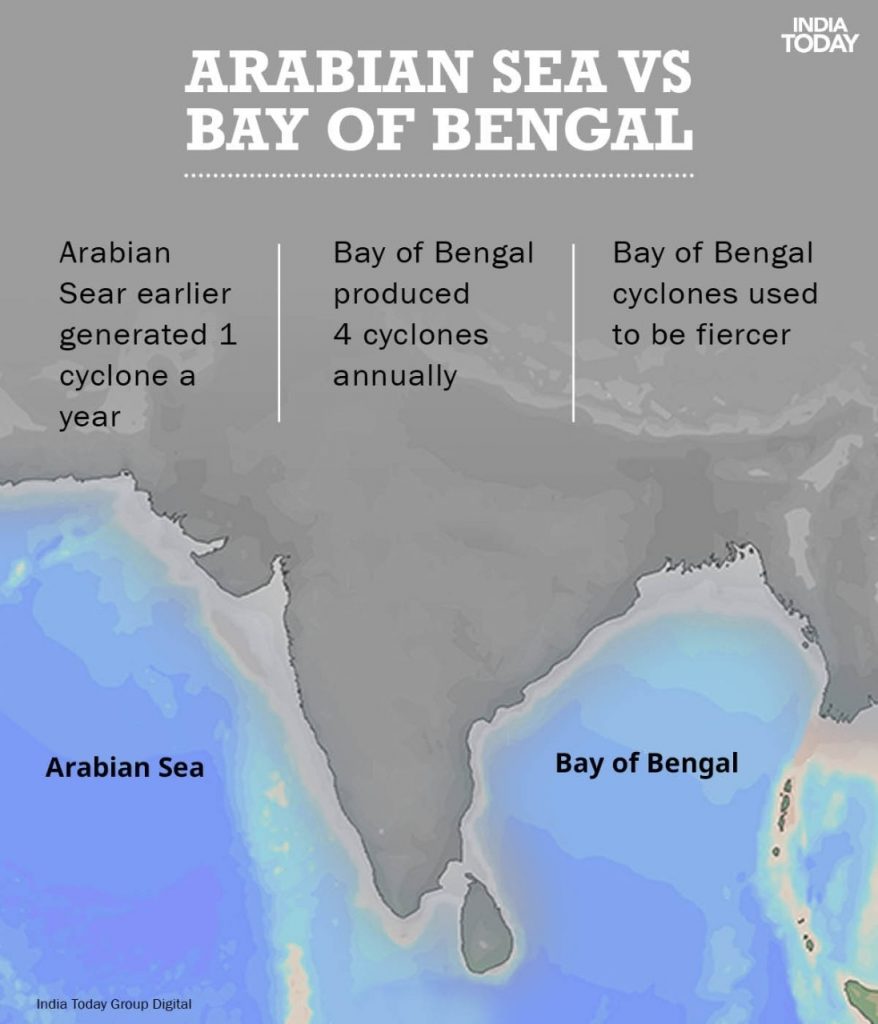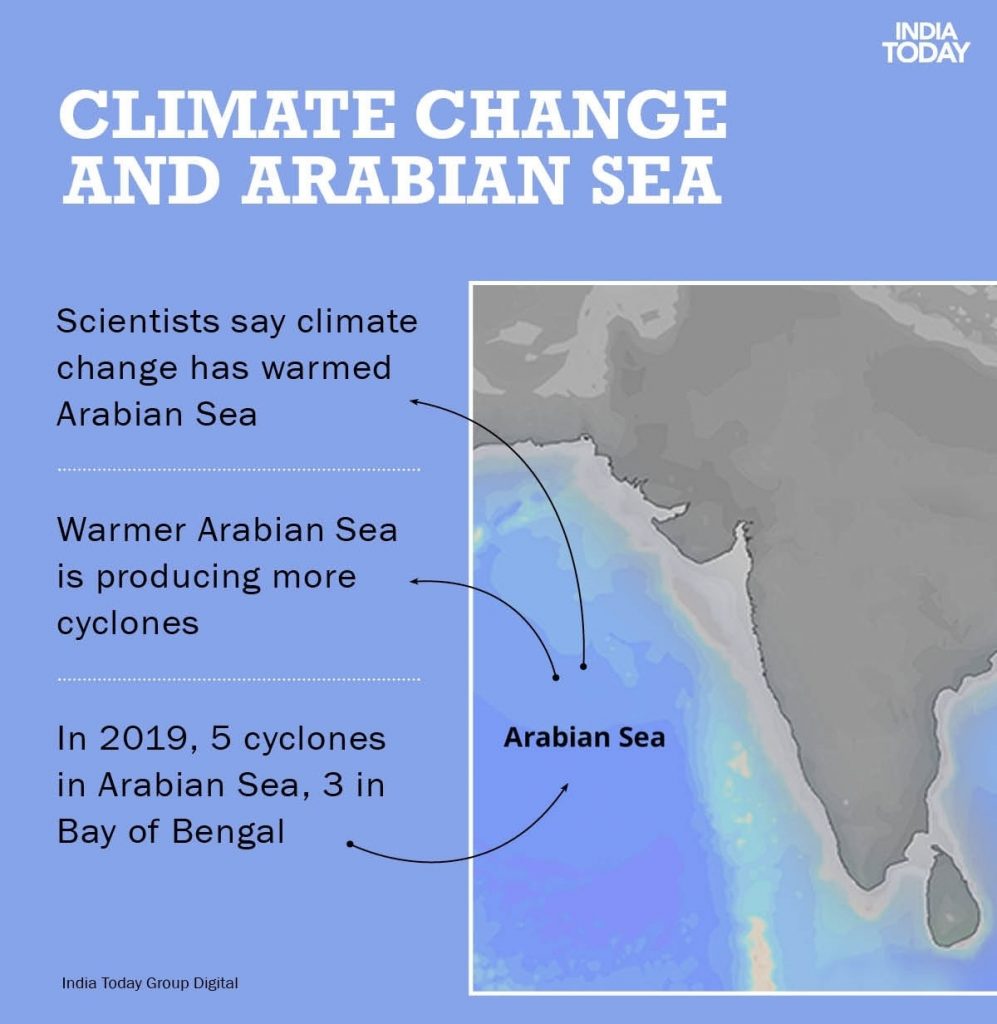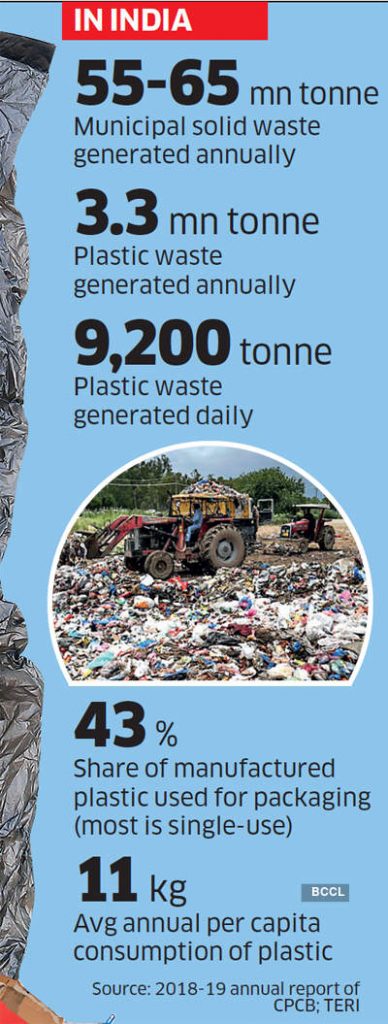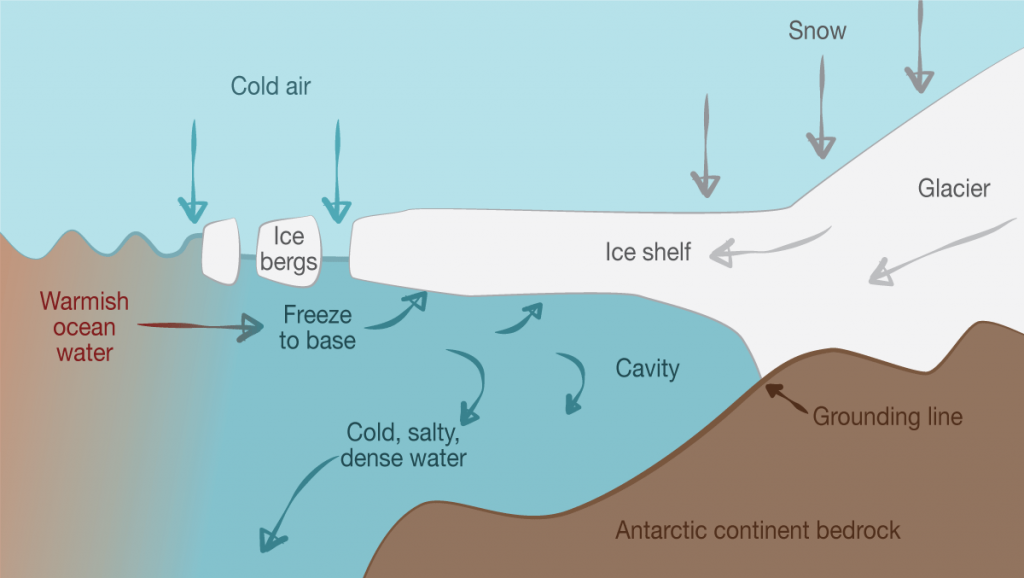Contents
- Cyclone Yaas, Increasing Tropical Cyclones
- Global surge in single-use plastic: Environmental hazard
- China completes strategic Tibet highway
- World’s largest iceberg breaks off from Antarctica
Cyclone Yaas, Increasing Tropical Cyclones
Context:
Cyclone Tauktae that was the first Extremely Severe Cyclonic Storm in the Arabian Sea to make landfall in Gujarat in 130 years. In less than a few days after the landfall of Tauktae, there is a possible cyclonic storm in the Bay of Bengal called Yaas.
Relevance:
GS-I: Geography (Physical geography – Climatology, Important Geophysical phenomena), GS-III: Environment and Ecology (Impact of Climate Change), GS-III: Disaster Management
Dimensions of the Article:
- Cyclone Yaas – a possibility
- Increasing numbers of cyclones in changing times
- Bay of Bengal vs Arabian Sea
- Increasing Cyclones in Arabian Sea
Cyclone Yaas – a possibility
- A low-pressure area is likely to form over North Andaman Sea and adjoining east-central Bay of Bengal around May 22, according to the India Meteorological Department (IMD).
- The depression will likely intensify into a cylone and move northwestwards, entering West Bengal and Odisha on May 26.
- Over 800 flood and cyclone shelters in the coastal pockets have been readied to house people from seaside villages in Odisha to deal with the cyclone.
- Odisha will witness a pre-monsoon cyclone for the third year in a row, after Amphan in May 2020 and Fani in May 2019. This is an incremental trend as – Odisha coast faced pre-monsoon cyclones (occurring between April and May) only 14 times since 1804.
Click Here to read more about the Formation of Cyclones
Click Here to read more about the Criteria used for Naming Cyclones
Increasing numbers of cyclones in changing times
- West Indian Ocean normally sees an extremely small number of cyclones and tropical storms compared to the Eastern side. – Between 1891 and 2000, almost 50 tropical cyclones impacted the west coast, of which more than 20 were severe cyclonic storms. In contrast, about 300 cyclones impacted the east coast of the country from the Bay of Bengal, including more than 100 severe cyclonic storms.
- Cyclones occur in the pre-monsoon months of May-June and the post-monsoon months of October-November.
- However, in the past few decades, the average number of storms to occur over the Arabian Sea and the time of the year when they do have both demonstrated a changing trend.
- In 2018, while the Bay of Bengal maintained its average of 4 cyclones a year, Arabian Sea gave rise to 3 instead of 1. A year later in 2019, the Arabian Sea saw 5 cyclones.
- Overall, there was a 32% rise in the number of cyclones between the years of 2014 and 2019.
- The changing trends are consistent with rising temperatures in the Indian Ocean. A 2014 study found that while the temperature of the Indian Ocean rose overall by 0.7 degrees Celsius, the generally colder western Indian Ocean experienced an unexpected warming of 1.2 degrees Celsius in the summer.
- Additionally, cyclones over the Arabian Sea are also increasing in intensity, driven by rising emissions and temperatures.
- Typically, an extremely severe cyclone occurs once every four to five years in the Arabian Sea, however, extremely severe Cyclone Nilofar in 2014 and Chapal and Megh in 2015, formed over the Arabian sea showing the increasing trend.
Bay of Bengal vs Arabian Sea
Near India, cyclones form on either side of the country, but the ones in the Bay of Bengal are more frequent and more intense than in the Arabian Sea.
Why Bay of Bengal creates significantly more cyclones?
- Apart from being a warm pool region, the Bay of Bengal is slightly more landlocked with South East Asian countries surrounding it, compared to the Arabian Sea, which is more expansive and this also leads to an increase in salinity of the seawater.
- The Bay of Bengal is fed by a constant source of freshwater in the form of giant rivers like the Ganga and the Brahmaputra. The river water that empties into the Bay of Bengal warms up at the surface and rises up as moisture. This makes it difficult for the warm layers of water to mix properly with the cooler layers of water below, keeping the surface always warm and ready to feed any potential cyclone over it.
- Furthermore, because of the shape of the land around the Bay of Bengal, the winds are slower and weaker over the ocean, ready to spin.
- According to experts, the Bay of Bengal also gets many remnants of the typhoons in the Pacific Ocean. They come as a low-pressure area into the Bay of Bengal and grow into cyclones due to ideal conditions.

Why are there lesser cyclones in the Arabian Sea?
- The northern, central and western parts of the Arabian Sea have a much cooler temperature. The mountains in east Africa direct winds towards the Arabian Peninsula, dissipating heat much more efficiently throughout the Arabian Sea.
- As a result, this region is not favourable to feed potential cyclones and about half the cyclones that move into this area typically lose energy and dissipate.
Increasing Cyclones in Arabian Sea
- For the past 150-200 years, the Bay of Bengal has given birth to four times more cyclones than the Arabian Sea. But this may soon change, thanks to global warming.
- A study by The Indian Institute of Tropical Meteorology has shown that both the frequency and intensity of cyclones in the Arabian Sea are on the rise. The experts believe the key reason is a rise in the ocean temperature.
- Traditionally, the Arabian Sea is a lot cooler than the Bay of Bengal. But now the Arabian Sea is also becoming a warm pool region because of the additional heat supplied by global warming.

-Source: Down to Earth Magazine
Global surge in single-use plastic: Environmental hazard
Context:
A detailed report published Minderoo, a nonprofit organization sheds new light on throwaway single-use plastic producers and the threats they pose as one of the world’s biggest environmental hazards.
Relevance:
GS-III: Environment and Ecology (Pollution Control and Waste Management, Environmental Degradation)
Dimensions of the Article:
- What are Single-Use Plastics?
- Highlights of the report on Production of Single-use plastics
- Steps taken to confront the Single-use plastic threat
What are Single-Use Plastics?
- Single-use plastics, or disposable plastics, are used only once before they are thrown away or recycled – example: plastic bags, straws, coffee stirrers, soda and water bottles and most food packaging.
- Instruments such as syringes, applicators, drug tests, bandages and wraps are often made to be disposable – and these are applications of single-use plastic that can’t be avoided easily. Single-use plastics also help in keeping food and water fresher for longer and reducing the potential for contamination – hence, they have been enlisted in the fight against food waste.
How is it a problem?
- Plastic is a huge problem as it is so cheap and convenient that it has replaced all other materials from the packaging industry leading to production at unprecedented levels – but it takes hundreds of years to disintegrate.
- Petroleum-based plastic is not biodegradable and usually goes into a landfill where it is buried or it gets into the water and finds its way into the ocean. In the process of breaking down, it releases toxic chemicals (additives that were used to shape and harden the plastic) which make their way into our food and water supply.
- Out of almost 10 million tonnes of plastic waste generated every year in India – 43% is single use plastic.

Highlights of the report on Production of Single-use plastics
- Half of the world’s single-use plastic is made by 20 big companies and their production is financed by financial services companies including banks.
- Governments are also big stakeholders in this industry, as about 40% of the largest single-use plastic makers are partly owned by governments, including China and Saudi Arabia.
- Single-use plastic has been a very good business, and that’s projected to continue. In the next five years alone, production capacity is forecast to grow by 30%.
- An average American uses and throws away 50 kilograms of single-use plastic every year whereas an average Indian uses less than one-twelfth of an American. – hence, there is a huge disparity between richer and poorer nations.
- It is far cheaper to make things out of newly produced plastic than from recycled plastic – hence a very small percentage gets recycled (about 8% of plastic gets recycled in the US).
- State and municipal governments have had success in banning certain items like plastic grocery bags, foam cups and drinking straws. But the efforts focused on curtailing the production of single-use plastic have been limited so far. Advocacy efforts to persuade consumers to use less plastic have failed to gain traction.
Steps taken to confront the Single-use plastic threat
- European Union issued a directive calling for consumer brands to use at least 30% recycled content in plastic bottles by 2025.
- In 2019, the Union government in a bid to free India of single-use plastics by 2022, had laid out a multi-ministerial plan to discourage the use of single-use plastics across the country.
- Plastic Waste Management Rules, 2016 which extended the responsibility to collect waste generated from the products to their producers and brand owners.
-Source: Hindustan Times, Indian Express
China completes strategic Tibet highway
Context:
China has completed construction of a strategically significant highway through the world’s deepest canyon in Tibet along the Brahmaputra river, enabling greater access to remote areas along the disputed border with Arunachal Pradesh in India.
Relevance:
GS-II: International Relations (India and its Neighborhood, Foreign Policies & Politics of Countries affecting India’s Interests)
Dimensions of the Article:
- About the Chinese Highway near Arunachal Pradesh Border
- China’s push in Border Infrastructure and reasons
- Concerns over Chinese transport-related infrastructure in Border
- Steps Taken by India to counter Chinese infrastructure in Border
- India’s Border Area Development Programme (BADP)
About the Chinese Highway near Arunachal Pradesh Border
- The Highway passes through the Grand Canyon of the Yarlung Zangbo river, as the Brahmaputra is called in Tibet. This is the “second significant passageway” to Medog county that borders Arunachal, directly connecting the Pad township in Nyingchi to Baibung in Medog county.
- The construction, which began in 2014, is part of a wider infrastructure push in border areas in Tibet.
- Recently, China has also started working on a strategically important railway line which is its second major rail link to Tibet that will link Sichuan province with Nyingchi, after the first rail link – Qinghai-Tibet railway that opened in 2006.

China’s push in Border Infrastructure and reasons
- A part of the border infrastructure push is the construction of new civilian settlements — along with the expansion of existing smaller hamlets — along border areas, some of which lie in disputed territories claimed by India and Bhutan, to strengthen China’s control over the land.
- In 2017, the Tibet Autonomous Region (TAR) government launched a plan to build “moderately well-off villages” in border areas, of which many would be developed in the prefectures of Ngari, Shigatse, Shannan and Nyingchi, along China’s borders with India, Bhutan and Nepal.
- In 2020, satellite images emerged showing a new village called Pangda built 2-3 km into what Bhutan sees as its land.
- In January 2021, another village built newly 4-5 km into what India sees as its territory in Arunachal came to light via satellite images. Indian officials said this land has been under China’s effective control since 1959 and there were military barracks there earlier.
- The civilian settlements, along with the new infrastructure connectivity, are seen as aimed at bolstering China’s control over the areas.
Concerns over Chinese transport-related infrastructure in Border
- Infrastructure such as the Highway in Arunachal Pradesh border or the Qinghai-Tibet railway line will largely improve the efficiency and convenience of military personnel and material transportation and logistical supplies in the border area.
- In situations of direct standoff near Arunachal Pradesh border, as was seen during Doklam or recent Ladakh standoff, China might be at an advantageous position – thanks to such roads and railway lines.
- The fragile ecological environment in the areas where such projects are undertaken by China, may have ecological concerns for India.
Steps Taken by India to counter Chinese infrastructure in Border
- The Border Roads Organisation (BRO) constructed the Daporijo bridge over Subansiri river in Arunachal Pradesh which links roads leading upto the Line of Actual Control (LAC) between India and China, in a record span of just 27 days.
- The foundation of a tunnel at Nechiphu in West Kameng district of Arunachal Pradesh which will shorten travel time for troops till the LAC through Tawang, which China claims to be its territory was laid.
- The BRO is already constructing an all-weather tunnel under the Se La pass in Arunachal Pradesh which connects Tawang to the rest of Arunachal and Guwahati.
- The state government of Arunachal Pradesh has advocated selection of 10 census towns along the India-China border as pilot projects for infrastructure development in order to stop people living along its international borders, specifically with China, from migrating to faraway urban centres in the State.
- Sisseri River Bridge located at lower Dibang Valley in Arunachal Pradesh connecting Dibang Valley and Siang was inaugurated.
- In 2019, the Indian Air Force inaugurated resurfaced runway at India’s easternmost Village-Vijaynagar (Changlang district) in Arunachal Pradesh.
- Bogibeel bridge, which is India’s longest road-rail bridge connecting Dibrugarh in Assam to Pasighat in Arunachal Pradesh was inaugurated in 2018.
- India is set to spend 10% funds of the Border Area Development Programme (BADP) only to improve the infrastructure along the China border.
India’s Border Area Development Programme (BADP)
- The Border Area Development Programme (BADP) was launched by the Ministry of Home Affairs in 1986-87 as part of a comprehensive approach to Border Management.
- BADP was initiated in the border areas of the western region during the Seventh Five Year Plan (1985-90), for ensuring balanced development of border areas through development of infrastructure and promotion of a sense of security among the border population.
- It is a centrally sponsored scheme. Funds are provided to the states as a non-lapsable special central assistance for the execution of projects relating to infrastructure, livelihood, education, health, agriculture and allied sectors.
- The States covered are Arunachal Pradesh, Assam, Bihar, Gujarat, Himachal Pradesh, Jammu & Kashmir, Manipur, Meghalaya, Mizoram, Nagaland, Punjab, Rajasthan, Sikkim, Tripura, Uttar Pradesh, Uttarakhand and West Bengal.
-Source: The Hindu
World’s largest iceberg breaks off from Antarctica
Context:
A huge ice block has broken off from western Antarctica into the Weddell Sea, becoming the largest iceberg in the world and earning the name A-76.
It is the latest in a series of large ice blocks to dislodge in a region acutely vulnerable to climate change, although scientists said in this case it appeared to be part of a natural polar cycle.
Relevance:
GS-III: Environment and Ecology (Climate Change and related issues), GS-I: Geography
Dimensions of the Article:
- What are Ice shelves?
- What are Icebergs?
- About the A-76 Iceberg
- What is Calving?
- Reasons for Calving of A-76
What are Ice shelves?
- An ice shelf is a floating extension of land ice. The Antarctic continent is surrounded by ice shelves.
- Ice-shelves cover more than 1.5 million square kilometers in Antarctica – fringing 75% of Antarctica’s coastline, covering 11% of its total area and receiving 20% of its snow.
- The difference between sea ice and ice shelves is that sea ice is free-floating; the sea freezes and unfreezes each year, whereas ice shelves are firmly attached to the land.
- Sea ice contains icebergs, thin sea ice and thicker multi-year sea ice (frozen sea water that has survived several summer ‘melt-seasons’, getting thicker as more ice is added each winter).

Receding Ice-shelves
- Ice shelves around the Antarctic Peninsula are retreating as they are warmed from below by changing ocean currents which thins them and makes them vulnerable.
- During warm summers, ice shelves calve large icebergs – and in some cases, can catastrophically collapse.
What are Icebergs?
- Chunks of ice that float, which are greater than 5 meters across are called “icebergs”.
- Icebergs are floating all around Antarctica after they calve off from tidewater glaciers or ice shelves.
- 90% of the mass of an iceberg is underwater, and only a small part of the iceberg is visible above the water level. S
- Icebergs float in a stable position, with their long axis parallel to the water surface. Elongated icebergs will float on their side.
- Icebergs can have many colours. Blue icebergs are formed from basal ice from a glacier. The compressed crystals have a blue tint. Green and red icebergs are coloured by algae that lives on the ice.
- Stripy icebergs are coloured by basal dirt and rocks, ground up by the glacier and carried away within the glacier ice. Crevasses and other glacier structures may be preserved, giving yet more texture and beauty to the iceberg.
About the A-76 Iceberg
- The A-76 iceberg, measuring around 170 km long and 25 km wide, with an area of more than 4300 sq km calved off from the Ronne Ice Shelf, is now floating in the Weddell Sea.
- A-76 joins previous world’s largest title holder A-23A — approximately more than 3800 sq. km. in size — which has remained in the same area since 1986.
- A-76 was originally spotted by the British Antarctic Survey and the calving — the term used when an iceberg breaks off — was confirmed using images from the Copernicus satellite.
- The Ronne Ice Shelf is located along the southern shores of the Weddell Sea. It is the western part of the larger Filchner–Ronne Ice Shelf, which is split at its leading edge by Berkner Island.
- Icebergs are named by the US National Ice Center, who assigns them a letter-number designation based on what part of Antarctica they originated from and when they formed.

What is Calving?
- Calving is the glaciological term for the mechanical loss (or simply, breaking off) of ice from a glacier margin.
- Calving is most common when a glacier flows into water (i.e., lakes or the ocean) but can also occur on dry land, where it is known as dry calving.
- In lake-terminating (or freshwater) glaciers, calving is often a very efficient process of ablation and is therefore an important control on glacier mass balance.
- Calving is also important for glacier dynamics and ice retreat rates.
Calving processes
- Before calving occurs, smaller cracks and fractures in glacier ice grow (or propagate) into larger crevasses.
- The growth of crevasses effectively divides the ice into blocks that subsequently fall from the snout into an adjacent water-body (where they are known as icebergs).
There are several main calving mechanisms at freshwater glaciers:
- Stretching and crevassing of ice – The faster flow of ice near the terminus (snout or end) due to basal sliding causes the ice to ‘stretch out’, and crevasses to propagate through the glacier.
- Force imbalances at glacier terminus – At a floating glacier terminus, the outward-directed cryostatic pressure (i.e., the pressure exerted by ice) and inward-directed hydrostatic pressure (i.e., the pressure exerted by water) are out of balance, creating a zone of high stress at the ice surface, opening crevasses and promoting calving.
- Undercutting of a terminal ice cliff – Glacier ice at or below a lake waterline often melts at a faster rate than the ice above a lake waterline which will often erode a notch that undercuts the calving ice cliff.
- Buoyant forces at a glacier terminus – Where a glacier surface thins to below the level needed for ice flotation, the margin will become buoyant and lift off the bed causing large bending forces at the grounding line, the growth of large crevasses, and eventually calving.

Reasons for Calving of A-76
- Antarctic ice is increasingly vulnerable to warming ocean waters and changing weather patterns, and for some time, scientists have been raising the alarm regarding the amount of ice being lost from West Antarctica. However, since iceberg calving is part of the natural processes of an ice shelf, we cannot point to an event like this and say that this was caused by climate change.
- An uptick in the frequency of large iceberg formation would be a stronger indication that climate change was a direct factor. What happens after a calving event is significant, as well.
Recently in news: Thwaites Glacier – a.k.a. the ‘Doomsday Glacier’ in Antarctica: Click Here to read more about the Thwaites Glacier threat
-Source: The Hindu



